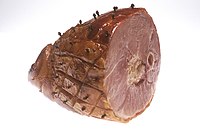
Photo from wikipedia
Abstract Most of the proteins present in mitochondria and chloroplasts, the organelles acquired via endosymbiotic events, are encoded in the nucleus and translated into the cytosol. Most of such nuclear-encoded… Click to show full abstract
Abstract Most of the proteins present in mitochondria and chloroplasts, the organelles acquired via endosymbiotic events, are encoded in the nucleus and translated into the cytosol. Most of such nuclear-encoded proteins are specifically recognized via an N-terminal-encoded targeting peptide (TP) and imported into the organelles via a translocon machinery. Once imported, the TP is degraded by a succession of cleavage steps ensured by dedicated peptidases. Here, we retrace the evolution of the families of the mitochondrial processing peptidase (MPP), stromal processing peptidase (SPP), presequence protease (PreP), and organellar oligo-peptidase (OOP) that play a central role in TP processing and degradation across the tree of life. Their bacterial distributions are widespread but patchy, revealing unsurprisingly complex history of lateral transfers among bacteria. We provide evidence for the eukaryotic acquisition of MPP, OOP, and PreP by lateral gene transfers from bacteria at the time of the mitochondrial endosymbiosis. We show that the acquisition of SPP and of a second copy of OOP and PreP at the time of the chloroplast endosymbiosis was followed by a differential loss of one PreP paralog in photosynthetic eukaryotes. We identified some contrasting sequence conservations between bacterial and eukaryotic homologs that could reflect differences in the functional context of their peptidase activity. The close vicinity of the eukaryotic peptidases MPP and OOP to those of several bacterial pathogens, showing antimicrobial resistance, supports a scenario where such bacteria were instrumental in the establishment of the proteolytic pathway for TP degradation in organelles. The evidence for their role in the acquisition of PreP is weaker, and none is observed for SPP, although it cannot be excluded by the present study.
Journal Title: Genome Biology and Evolution
Year Published: 2022
Link to full text (if available)
Share on Social Media: Sign Up to like & get
recommendations!